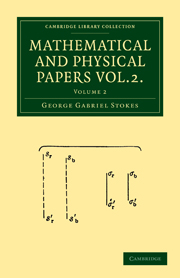Book contents
- Frontmatter
- Contents
- Notes on Hydrodynamics. III. On the Dynamical Equations
- On the constitution of the Luminiferous Ether
- On the Theory of certain Bands seen in the Spectrum
- Notes on Hydrodynamics. IV. Demonstration of a Fundamental Theorem
- On a difficulty in the Theory of Sound
- On the Formation of the Central Spot of Newton's Rings beyond the Critical Angle
- On some points in the Received Theory of Sound
- On the perfect Blackness of the Central Spot in Newton's Rings, and on the Verification of Fresnel's Formula for the intensities of Reflected and Reflacted Rays
- On Attractions, and on Clairaut's Theorem
- On the Variation of Gravity at the Surface of the Earth
- On a Mode of Measuring the Astigmatism of a Defective Eye
- On the Determination of the Wave Length corresponding with any Point of the Spectrum
- Discussion of a Differential Equation relating to the Breaking of Railway Bridges
- Notes on Hydrodynamics, VI. On Waves
- On the Dynamical Theory of Diffraction
- On the Numerical Calculation of a class of Definite Integrals and Infinite Series
- On the Mode of Disappearance of Newton's Rings in passing the Angle of Total Internal Reflection
- On Metallic Reflection
- On a Fictitious Displacement of Fringes of Interference
- On Haidinger's Brushes
- Index
On the constitution of the Luminiferous Ether
Published online by Cambridge University Press: 07 September 2010
- Frontmatter
- Contents
- Notes on Hydrodynamics. III. On the Dynamical Equations
- On the constitution of the Luminiferous Ether
- On the Theory of certain Bands seen in the Spectrum
- Notes on Hydrodynamics. IV. Demonstration of a Fundamental Theorem
- On a difficulty in the Theory of Sound
- On the Formation of the Central Spot of Newton's Rings beyond the Critical Angle
- On some points in the Received Theory of Sound
- On the perfect Blackness of the Central Spot in Newton's Rings, and on the Verification of Fresnel's Formula for the intensities of Reflected and Reflacted Rays
- On Attractions, and on Clairaut's Theorem
- On the Variation of Gravity at the Surface of the Earth
- On a Mode of Measuring the Astigmatism of a Defective Eye
- On the Determination of the Wave Length corresponding with any Point of the Spectrum
- Discussion of a Differential Equation relating to the Breaking of Railway Bridges
- Notes on Hydrodynamics, VI. On Waves
- On the Dynamical Theory of Diffraction
- On the Numerical Calculation of a class of Definite Integrals and Infinite Series
- On the Mode of Disappearance of Newton's Rings in passing the Angle of Total Internal Reflection
- On Metallic Reflection
- On a Fictitious Displacement of Fringes of Interference
- On Haidinger's Brushes
- Index
Summary
The phenomenon of aberration may be reconciled with the undulatory theory of light, as I have already shown (Phil. Mag., Vol. xxvil. p. 9), without making the violent supposition that the ether passes freely through the earth in its motion round the sun, but supposing, on the contrary, that the ether close to the surface of the earth is at rest relatively to the earth. This explanation requires us to suppose the motion of the ether to be such, that the expression usually denoted by udx + vdy + wdz is an exact differential. It becomes an interesting question to inquire on what physical properties of the ether this sort of motion can be explained. Is it sufficient to consider the ether as an ordinary fluid, or must we have recourse to some property which does not exist in ordinary fluids, or, to speak more correctly, the existence of which has not been made manifest in such fluids by any phenomenon hitherto observed? I have already attempted to offer an explanation on the latter supposition (Phil. Mag., Vol. XXIX. p. 6).
In my paper last referred to, I have expressed my belief that the motion for which udx + &c. is an exact differential, which would take place if the ether were like an ordinary fluid, would be unstable ; I now propose to prove the same mathematically, though by an indirect method.
- Type
- Chapter
- Information
- Mathematical and Physical Papers , pp. 8 - 13Publisher: Cambridge University PressPrint publication year: 2009First published in: 1883
- 1
- Cited by

